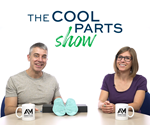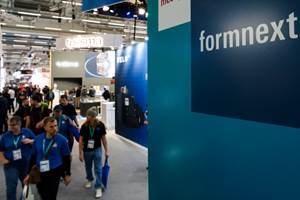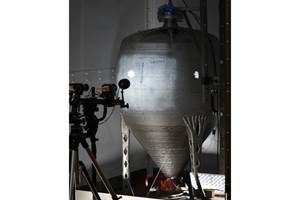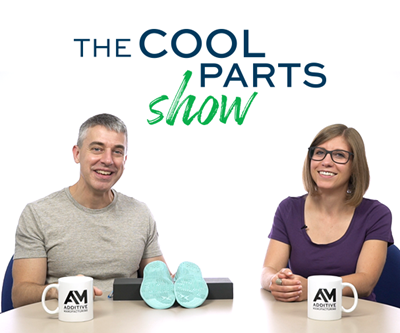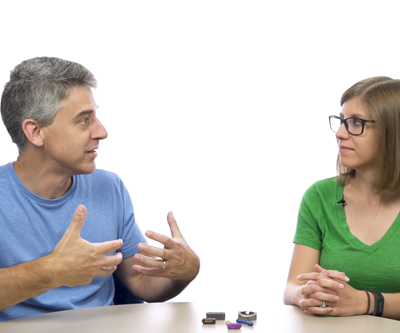8 Cool Parts from Formnext 2019: The Cool Parts Show #6
Editors Peter Zelinski and Stephanie Hendrixson attended Formnext 2019 in Frankfurt, Germany. Here are 8 cool 3D printed parts spotted on the show floor.
Share
Read Next
As arguably the largest event in additive manufacturing (AM), the annual Formnext trade show in Frankfurt, Germany, is the stage for major product launches, partnership announcements and application showcases. As a result, it’s also a great place to spot cool 3D printed parts. As the Additive Manufacturing team covered the 2019 show, we kept our “cool parts” radar on and collected many examples. In this special edition episode of The Cool Parts Show, we share 8 of the most interesting and striking parts we saw on the show floor. Watch below, and read our Formnext 2019 report for more detailed impressions from the show.
The Cool Parts Show is a video series from Additive Manufacturing Media that explores the what, how and why of unusual 3D printed parts. Watch more here.
Have a cool part to share? Email us.
Transcript
Pete Zelinski
Hey everyone, Cool Parts Show bonus episode.
Stephanie Hendrixson
We just got back from additive manufacturing's largest trade show. We're going to show you eight of the coolest parts that we saw there in this episode of The Cool Parts Show.
Pete Zelinski
I'm Pete Zelinski.
Stephanie Hendrixson
I'm Stephanie Hendrixson. We're with Additive Manufacturing Media.
Pete Zelinski
And this is The Cool Parts Show — sort of. So this year we launched our video series, The Cool Parts Show, all about cool 3D printed parts—amazing parts made through additive manufacturing! Season One is out there. Go watch every episode if you haven't. If you have, we haven't forgotten about you because we're working on Season 2.
This is something in between. This is a special bonus episode we decided to do because we just got back from the Formnext show in Frankfurt, Germany.
Stephanie Hendrixson
Right. So today we're going to show you eight of the coolest parts that we saw at the show. But before we do that, couple of things you might need to know about Formnext. It is probably the world's largest show for additive manufacturing. It takes place annually in Frankfurt, Germany. And it's huge. It was actually much bigger this year than it was last year. There's something like 852 exhibitors, and I think attendance was close to 35,000 people. So it was a really, really big event. And there was lots to see.
Pete Zelinski
Lots to see. Way too much to share with you, actually, but we’ve got some cool parts. Why don't you start, Stephanie?
Stephanie Hendrixson
OK, so cool part number one is something that I actually tweeted about while we were at the show. And the response on Twitter was so enthusiastic that I knew I had to include it in this countdown.
So what you're looking at are these two cylindrical parts. These are filters for a naval ship and the one on the left is the original metal part. You can see it's kind of corroded. There's some pieces of it missing. And that's a problem because this is a critical component that you need to operate a ship like this. So these things only have a lifespan of about nine months in the water, and once they get past that and they start to break down, you need to replace them. If you don't have a spare onboard, what they will have to do is actually have a spare part flown in via helicopter.
And so this is a scenario that actually happened. The ship was out at sea and the filter failed. And it just so happened that this particular ship had just recently brought an Ultimaker 3D printer onboard. And so rather than have the spare part flown in through helicopter, they printed the part themselves out of PLA, they put it in the water and it worked just fine. So actually, what you're looking at is the literal PLA filter that they printed and it was in use for more than a year. You can see it still looks really great. So this was a really good example of plastic replacing metal and also cost savings, not just in manufacturing, but the shipping costs to get this part where it was needed.
Pete Zelinski
All right. Part number two. So Divergent Technologies is all about trying to apply additive manufacturing to automotive production. A partner is SLM Solutions. They make additive manufacturing machines for metal using selective laser melting. And at Formnext, SLM Solutions’ booth included this display of a front quarter section of a working car produced by Divergent with all kinds of additively manufactured components you wouldn't expect to be made that way on a car.
So here's an example. Here is a front upper control arm part of the suspension. So what's really cool about this is the evolution of the form that you can see here. It was topology optimized. So the result is this crazy warpy fluid form that you wouldn't expect your car part to have. But additive manufacturing makes that possible. Print exactly the form you want and therefore get exactly the crazy geometric shape that gives you the perfect combination of the strength of the part and lightweight overall.
Stephanie Hendrixson
It's always cool to see that progression when you look at topology optimized parts because it seems like it's never, you generate one design and that's what you go with. You go through multiple iterations.
Pete Zelinski
Yeah. So additive makes it easier to iterate like that. But I also think a day is coming when a whole lot more of the objects in our world look weird like that.
Stephanie Hendrixson
All right. Part number three is something that I saw in HP's booth. This is a helmet made by a company called Kupol. It's a motorcycle helmet. The outer shell is PA 11, that hard nylon that you see from a lot of HP prints, and then there's this mesh on the inside. That's a TPU material made by BASF, one of the newer materials for Multi Jet Fusion. And you might look at this and think that this is a multimaterial print and it's actually not. What you're looking at is actually an example of assembly de-consolidation. So if you think about a motorcycle helmet, it's this hard outer shell and you've got all this padding inside. And to get it on, you have to kind of like manipulate your ears and it's not a super comfortable experience. So what they've actually done is divide those two different parts of the helmet. The mesh is just kind of like this cap that you can really easily get on over your ears and then the shell is something you can just kind of slide on over top. And so I just thought this was a really interesting example of how additive makes us, you know, take another look at everyday objects and kind of reimagine them.
Pete Zelinski
And you know what? The ability to 3D print TPU, that's going to figure into a lot of the parts in this list.
Okay. So here's an example. Part number, what are we four? Part number four. So this is from a two-material part to a three-material part. This is a splint. It is a splint tailor-made to the patient based on a scan of the patient's wrist and hand. This was made through the combination of three different materials all coming together in the same build. It was made with Arburg's Freeformer process, which is a material extrusion process, but carbon fiber is also continuously fed in where it applies. So the different materials here, what you're looking at is the hard outer shell. The form of this is ABS hard plastic. Then for reinforcement, carbon fiber is laced in at strategic points to make the splint stronger. It's laced in as a continuous fiber so that it's embedded within that solid ABS part.
And then the hinge there, it's our TPU. It is 3D printed TPU to give just the flexibility in that one area of the splint where it's needed. So this three-material 3D printed form, three materials elegantly producing just one complete part, build time for this was about seven hours.
Stephanie Hendrixson
All right. cool part number five. So, Pete, we've been talking a lot this year about the interaction between robots and 3D printing. Right? So what I have for this part is an example of an end effector. So this is a robot end effector made by a company called All Axis Robotics. They're a machine shop and they also do robotic automation integration. And they 3D printed this end effector on their Makerbot MethodX. This is the new platform from Makerbot. It's made out of ABS, and they also used SR-30, which is the Stratasys support material, which is now supported on this new platform.
I thought this end effector was kind of interesting because it's for a deburring application and there's actually places for two different grits. So you have two different abrasives and the robot can kind of sand with one side and then flip over and sand the other way. And there's also a connector for a vacuum there so you're trapping all of that dust as it's generated. But I thought this was cool also because if you were going to machine this out of aluminum, it would be a couple thousand dollars for for this end effector. And they were able to 3D print it much faster and it only cost them about ten bucks.
Pete Zelinski
Okay, cool part number six. Okay. So Stephanie, I'm like I'm searching my memory. I feel like in the past we've done an episode on customized 3D printed shoe insoles. Does that sound familiar?
Stephanie Hendrixson
Yes, definitely.
Pete Zelinski
All right. So here's insoles for ski boots. Also tailor-made. Think about it. The argument for custom insoles makes even more sense with ski boots. The comfort and control you have with skiing is influenced on what kind of contact your foot has with the boot. Right. So this is by Tailored Fits, the company providing this. They scan your foot using an iPad, get your foot geometry that way. And then the custom-made insole, TPU again, is 3D printed by Materialise, which is a well-established additive manufacturing service provider.
Stephanie Hendrixson
Part number seven is a 3D printed cutting tool. We've seen stuff like this before. Like Pete, you just did a roundup of cutting tools that you saw at EMO this year made additively, and so this is kind of another example of that. But it's interesting because it's made with a new metal 3D printing process.
This cutting tool came from Incus. They're a spin out of Lithoz which you might recognize for ceramics 3D printing. But this is a dense metal tool made with this new process that's kind of stereolithography that kind of looks like powder bed fusion. So what you have is this feedstock that is a photopolymer with metal powder inside of it. It's sort of the consistency of butter, is how they described it to me. And so there's a blade that is kind of wiping this across the build platform. You use digital light projection to cure the polymer and then those green parts that you end up with need to go through debinding and sintering to to become fully dense.
One of the interesting things that I learned in talking to them is that a lot of the surface finish and other problems you might have with powder bed fusion are a result of the loose powder and how it behaves. And so when you have more of a solid feedstock, you mitigate some of those issues. You can see on this part, the surface finish is really, really smooth. You can also get pretty fine details. So they had a lot of really small, intricate little parts in their booth too.
Pete Zelinski
Our eighth cool part from Formnext. This is a brand-new metal never seen before. So 6K makes powder for additive manufacturing. Metal additive processes frequently start with powder, special metal powder, among other things. The grains have to be very spherical. What's different about 6K's process is they do not need something like wire or ingot as an intermediary step in making this powder. Instead, their feedstock is this... It looks like a rough powder, and the feedstock is little grains that are compressed together mechanically. And the thing about that is, that mechanical compression into a rough powder feedstock, it can hold together metals that have radically different melting points, hold them together just long enough that they can alloy together.
So 6K at Formnext just to kind of show off what they could do they put together a bunch of metals, all very, very different melting points across a big range and just alloy them together to show that it's possible. That's what this cube is. This alloy is so new, it doesn't even have a name yet.
Stephanie Hendrixson
All right. So that was a lot. We talked about materials. We talked about robots. We talked about mass customization. And those are just kind of like eight of the most photogenic things that we saw at the show. Right. So there's a lot more to it. If you're interested in reading more about Formnext, including the product launches, the themes, our impressions of the show, we will have a link to our detailed report in the show notes or at additivemanufacturing.media.
Pete Zelinski
So I guess that does it for the Formnext special edition of The Cool Parts Show. If this is your first time seeing the show, go watch Season 1. All the episodes are out there. Go binge.
Stephanie Hendrixson
And if you have a cool 3D printed part that you'd like to see featured, email us. Coolparts@additivemanufacturing.media.
Pete Zelinski
Be sure to subscribe so that you know exactly when Season 2 drops. Thanks for watching.
Related Content
Evolve Enhances Portfolio With Global Parts Service, Two More Materials
Formnext 2023: New parts production service and two more material offerings enable greater commercial access to Evolve’s STEP technology, which can expand application development for STEP production around the world.
Read More7 Things We Saw at Formnext 2024 — Video Playlist
There were countless processes, applications and announcements at Formnext 2024. Here are seven standouts Peter Zelinski and Stephanie Hendrixson caught on film.
Read MoreWhat We Found at Formnext 2023
New metal processes, new possibilities for existing processes, the next step for copper and more. Here is a summary drawing on all our reporting from November’s event.
Read MoreFinland’s Largest Metal 3D Print Withstands Pressure Vessel Test, Vastly Exceeding Expectations
The pressure vessel was created in cooperation between Andritz Savonlinna Works and the Finish Additive Manufacturing Ecosystem (FAME), and withstood the nondestructive and destructive tests carried out by LUT University.
Read MoreRead Next
Shoe Insoles Precisely Tailored to Individual Feet: The Cool Parts Show #4
This episode of The Cool Parts Show looks at how 3D printing will deliver tailored products. Scanning feet for their geometry and pressure enables Aetrex and EOS to manufacture insoles that are unique to individual wearers.
Read More“The Cool Parts Show” Season One Now Complete: Here is Why We Launched the Show and How You Can Help
Our YouTube series showcases the parts and possibilities additive manufacturing is making real. Will you help us reach future AM users?
Read MoreBike Manufacturer Uses Additive Manufacturing to Create Lighter, More Complex, Customized Parts
Titanium bike frame manufacturer Hanglun Technology mixes precision casting with 3D printing to create bikes that offer increased speed and reduced turbulence during long-distance rides, offering a smoother, faster and more efficient cycling experience.
Read More
.jpg;width=70;height=70;mode=crop)

